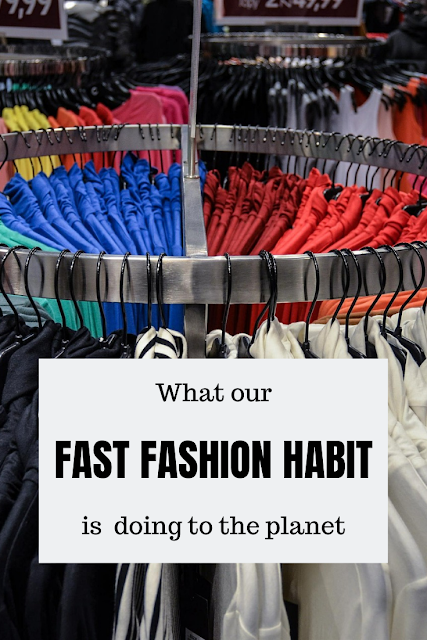The term fast fashion has changed slightly over recent years. It originally meant the practice of high street clothes stores producing cheap clothes, quickly, based on clothes on the cat walks of the most recent fashion shows. Now, though, it has taken on somewhat of a further sense to mean the way many people view and use cheap clothes - fast fashion is where people buy a fashionable item, wear it once once or twice and then throw it away. The clothes are generally cheap, imported and of low quality but the wearer doesn't see or care about this. They buy them to satisfy their Fast Fashion Habit. In fact, the term Single Use Clothing could be used in many cases.
Vast amounts of all these fashion items end up in landfill day after day and remember, the term fashion doesn't just apply to clothes - it includes shoes and accessories such as bags, belts and hats. In America fashion items make up more than 9 percent of solid household solid waste meaning on average each American throws away about around 81 pounds (36kg or 5½ stones) every year. Source - EPA Estimates. And this doesn't account for all the packaging these clothes came in.
Whilst much clothing can be recycled many people do not know this or the infrastructure is not there to facilitate recycling which explains why so many clothes go to landfill. And clothing made from mixed fibres such as 50% cotton/50% polyester is almost impossible to recycle anyway.
Giving to charity is not necessarily the answer, either. Whilst it is fair to say some people do take their fast fashion items to charity shops or place them in textile recycling bins there are simply too many clothes to deal with - with an estimated 80 million items of clothing being purchased across the globe annually, charities cannot cope and many charity shops are now refusing cheap fast fashion items. In other cases they sell them on to third world countries but this is not a sustainable solution. By flooding their markets with the clothing rejects from the West, the knock on effect is that local textiles industries are being destroyed.
Our insatiable appetite for more and more clothes is having a very real negative effect on the planet. Take the Aral Sea on the borders of Kazakhstan and Uzbekistan. It used to be the world's 4th largest inland lake but in the 1960's the desert area around it was developed as an "ideal" location for growing cotton. Water from the Aral Sea was used to irrigate the desert and the cotton the area grew fed the rapidly expanding clothing industry. Estimates vary but it is stated that it takes somewhere between 1000 and 1800 US gallons of water to make one pair of jeans - even at the lower estimate that is 3785.41 litres or 3.78 cubic metres of water for EVERY pair of jeans made. In less than 30 years this has had a devastating effect on the Aral Sea. The picture on the left was taken in 1989 and the one on the right in 2014. Remember this used to be the world's 4th largest inland lake.
 |
| By NASA. Collage by Producercunningham. - 1989: aral sea 1989 250mFile:Aralsea tmo 2014231 lrg.jpg, Public Domain, https://commons.wikimedia.org/w/index.php?curid=35813435 |
The Aral Sea has been renamed the Aralkum Desert. But worse than just being turned to desert, so many pesticides were poured onto the cotton fields that the desert is now also highly polluted and even with irrigation it is unlikely it could grow anything.
With more people rejecting clothing made from man-made materials in favour of natural materials such as cotton, without a reduction in our overall consumption of clothing we are only going to see more examples of disappearing fresh water and changed/poisoned landscapes. The bottom line is that that the cotton in your jeans or your t-shirt or whatever cotton clothes you have in your wardrobe may well be advancing the loss of fresh water habitats.
There are probably thousands of articles online about how to break your fast fashion habit (I've linked to one here > 10 simple steps to dress sustainably) so I am not going to repeat the information in this blog. But you might also want to read the following articles if you need any further convincing that we REALLY need to change our attitude to the clothes and fashion items we buy.
Sources and further reading:
- How Many Gallons of Water Does it Take to Make a Single Pair of Jeans?
- World of Change: Shrinking Aral Sea
- How second-hand clothing donations are creating a dilemma for Kenya
- We Buy A Staggering Amount Of Clothing, And Most Of It Ends Up In Landfills
- This teacher wore the same dress for 100 days
Are you willing to break your addiction to fast fashion to help save the planet?




Very insightful. I knew it wasn't the answer, but didn't realise by sending clothes to third world countries we would also be destroying their local industry. We try to avoid fast fashion where possible, we pass clothes down and have capsule wardrobes to reduce the number of items we need. The difference in the Aral Sea is scary!
ReplyDeleteI didn't think about the effect on local textile industries either. We do very much the same as you to keep down how many clothes we have and I certainly own clothes from 20 years ago that I still wear.
DeleteIt's staggering that we can change inland lakes such as the Aral Sea to desert in just 30 years. I knew that growing cotton uses a lot of energy but didn't know it could have as devastating an effect as this.
ReplyDeleteThank you for illustrating this - making do with what we have and mending is definitely the way forward.
I read about it in a book that wasn't particularly environmentally themed and I was so shocked so went and found out more about it. So so sad.
Delete...And all in the name of making money. Really sad.
DeleteGreat post and such an important topic... I do love my clothes but rather buy an expensive piece (made from natural fibre) that I will wear for years - saying this even if natural fibres won't pollute our waterways, there are so many other issues ranging from production related to ethical issues relating to their production. I think there needs to be a lot more transparency within the entire industry...
ReplyDeleteReduce, reuse, recycle, repurpose- these are our constant mantras, and to see such a consumer-centric approach to clothing is appalling. The pollution levels associated with the garment industry are now topping the list of causes for green house gas emissions and the destruction of the ozone layer, as well as the sterilization of the land-
ReplyDeleteDoing what we can for ourselves is no longer enough.
Thank you for this critical and important share-
The top I'm wearing today I use to wear when I worked in an office and that was over 13 years ago! I can't remember when I bought my jeans but now the knees have that worn look which people pay extra for with new jeans! One of my daughter's favourite items of clothing is a tartan dress I gave her which I bought when I was 19. Unless your clothes are threadbare or don't fit I don't still the point in getting rid of them.
ReplyDeleteHi Rosie,
ReplyDeleteExcellent article. There is so much waste in clothing being thrown away that could be recycled or reused in many different ways. Sharing on social media.
I no longer buy cheap clothing, i prefer to have a few good quality essential items and will jazz them up with a handful of accessories #goinggreen
ReplyDeleteI buy all of my clothing at thrift stores, partly for this reason and partly to reduce my spending. I know so many people who turn their noses up at thrift shops and buy a ton of clothing...it makes me sad. :( Thanks for sharing! I am sharing your post with my friends.
ReplyDeleteI like slow fashion. I'm wearing an all me-made outfit today. I'm fully aware that my craft materials are being produced in the same way as the shop bought clothes and use just as much water, but I make less and they last longer, so fewer items. They will be repaired and upcycled eventually. I'm always on the lookout for better sources of fabric and yarn. Saw a TV program recently about the Aral sea/desert. So shocking.
ReplyDeleteI've seen these statistics several times, but I'm yet to meet anyone that actually throws clothes away after just a few wears. I have clothes and accessories that I've had for 20-odd years. Who are these people that are doing this?
ReplyDeleteYounger people with disposable income who have been brought up in a throw away culture. I know teenage children of my friends who do this :(
DeleteVery good article, Rosie. I've always despised the fast fashion, throwaway culture that has taken hold over the last couple of decades. It helps that I don't like shopping though! Those aerial views of the Aral Sea are scary - and this is happening all over the world to feed the consumerist beast.
ReplyDelete#GoingGreen